지지씨
TANGIBLE HERITAGES OF NAMHANSANSEONG - DESIGNATED CULTURAL PROPERTIES
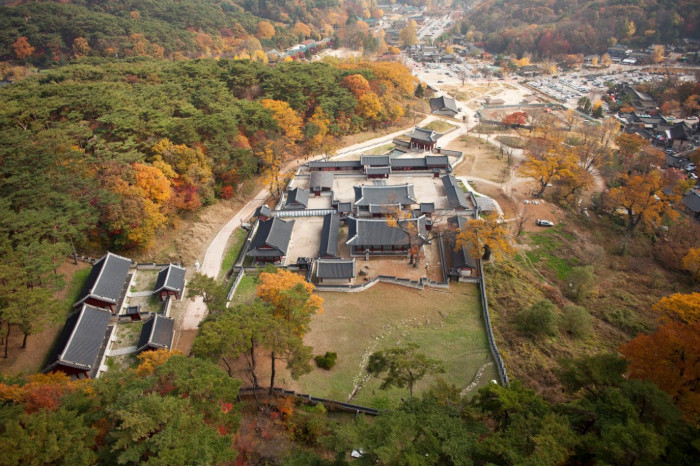
Temporary Palace at Namhan Mountain Fortress
A district administration office for Gwangju was moved to Namhan Mountain Fortress upon its completion, establishing its status as a functioning fortress. In addition, a temporary palace (行宮 Haenggung) was completed below the West Command Post in the 9th moon of 1624, while the fortress walls were being built.
This palace compound, which was known as either Gwangju Haengung or Namhan Haenggung, consists of two sections, upper and lower. Important structures on the site included Jwajeon (左殿 Left Hall), Usil (右室 Right Hall), Jaedeokdang (在德堂 Hall in Virtue), Hannamnu (漢南樓 Hannam Pavilion) and Inhwagwan (人和館 Human Harmony Guesthouse). The compound, fit for the residence of a king, had a total of 227 compartments, or kan (間 unit for the space enclosed by four pillars). The upper section consisted of 73 kans, while the lower section had 154. "Haenggung" (行宮 travel palace), or "Haengjaeso" (行在所 a place to stay when traveling), refers to a place where the king could rest while outside the capital. King Injo resided here for 47 days (14th day of the 12th moon, 1636 until the 30th day of the 1st moon, 1637) during the Manchu Invasion. Kings Sukjong, Yeongjo and Jeongjo also stayed here while on trips to royal tombs to perform sacrifices. As such, this temporary palace compound played a more important role in history than other compounds of its type did.
The royal compound at Namhansanseong had 18 buildings and a total of 33 structures when including various gates and so on. The buildings can be classified according to purpose: the temporary palace halls, the "left-side hall," and the local administration halls.
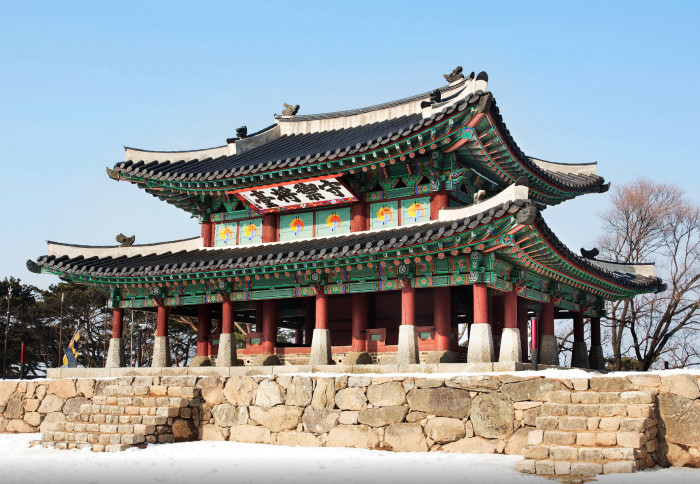
Sueojangdae Post, West Command Post
Sueojangdae (守禦將臺 Defense Commander's Post) is a two-story military facility used for observation as well as for directing battle. This structure was built in 1624 as one of five (two in the east and one each in the other directions) command posts inside Namhan Mountain Fortress. Today, Sueojangdae is the only one that remains. It sits atop 482m Cheongryang-san (Mountain) and offers a panoramic view of the fortress interior as well as the cities of Yangju, Yangpyeong, Yong-in, Goyang, Seoul and even Incheon. Originally the lookout was built as a one-story structure called the West Command Post (西將臺).
The Namhan Mountain Fortress Defense Command (守禦廳 Sueocheong) was organized into five divisions (Front, Left, Right, Center, and Rear), and this post was for the Commander of the Right. During the Manchu Invasion of 1636 King Injo himself helped to direct and encourage the troops from here. They held out for 47 days against a Qing force of 130,000. In 1751, Special Mayor Yi Gi-jin, on orders from King Yeongjo, had a second story built on the West Command Post.
The tablet on the outside reads Sueojangdae (Defense Commander's Post), but inside another tablet is inscribed with the words "2-story Tower of No Forgetting" (無忘樓). It serves as a constant reminder to succeeding generations of the hardship suffered by King Injo when he surrendered to the Qing as well as by the Crown Prince. King Injo's son was held hostage for 8 years in Shenyang (China), and after he became King Hyojong he plotted a retaliatory expedition against the Qing, but it never came to pass. King Hyojong was buried in a royal tomb at Yeoju, and his descendents, Kings Yeongjo and Jeongjo, would periodically visit the tomb to perform ancestral memorial services. On the way, the Joseon monarchs would stop by this command post and reflect on the humiliation that it represented for all in the kingdom.
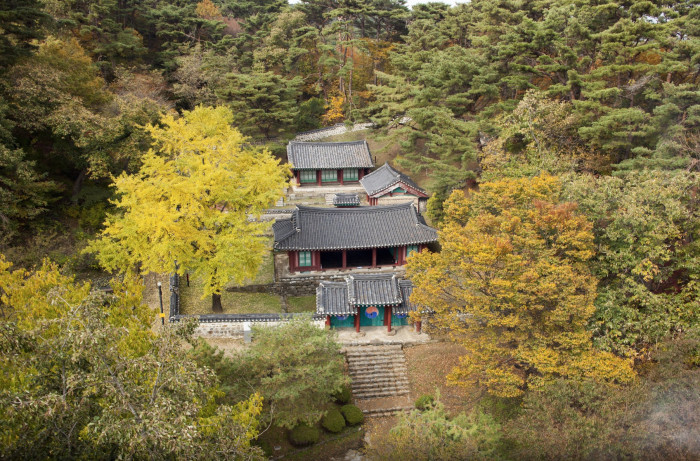
Sungryeoljeon Shrine, A shrine to house the spiritual tablets of King Onjo and general Yi hoe
The spirit tablets of Baekje Founder/King Onjo and General Yi Seo, who directed the construction of Namhan Mountain Fortress in 1624, are enshrined in Sungryeoljeon (崇烈殿 Revere-the-Ardent Hall). Ceremonies are conducted to them on the 5th day of the 9th lunar month. The shrine was constructed in 1638, and the tablet bears the characters "sungryeol" (崇烈) that were styled in the hand of King Jeongjo in 1795. Inside the hall are separate shrines: the main shrine to King Onjo is above, while the secondary shrine to General Yi is below. A second building is used to store the implements and utensils used in the memorial rites. Below the wicket door to the shrine hall are a lecture hall and the front gate. Kings as well as subjects come here to show their respects at a shrine that may have been inspired by a dream.
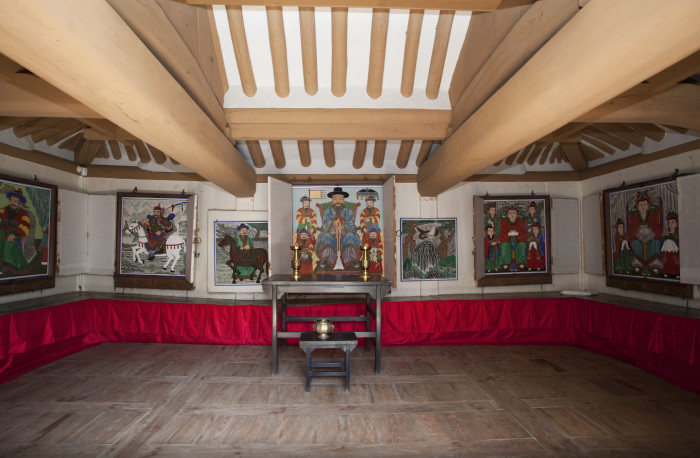
Cheongryangdang, Shaman Shrine
Cheongryangdang (淸凉堂 Cool & Clear Hall) is associated with the following tale: This is a shrine to Yi Hoe, his wife and his concubine. Yi was assigned to work on the southeastern section of the wall when the fortress was being rebuilt in 1624. However, he was slandered for having squandered funds for the project, shirking his duties, and failing to meet his work quota.
For his he was sentenced to die. Hearing of his plight, his wife and concubine raised money and were coming up from the south to help him at the fortress. On the way, they heard that their husband had been executed and killed themselves by jumping into a river. A reinvestigation of his case revealed that Yi had actually worked steadfastly and sincerely, and that he had been falsely accused. Then this shrine was built beside the West Command Post to offer solace to his soul. Enshrined here were portraits of Yi Hoe, flanked by those of Great Monk Byeokdam on the right and his wife and concubine on the left. The original images were lost during the Korean War, and the ones used today are reproductions.
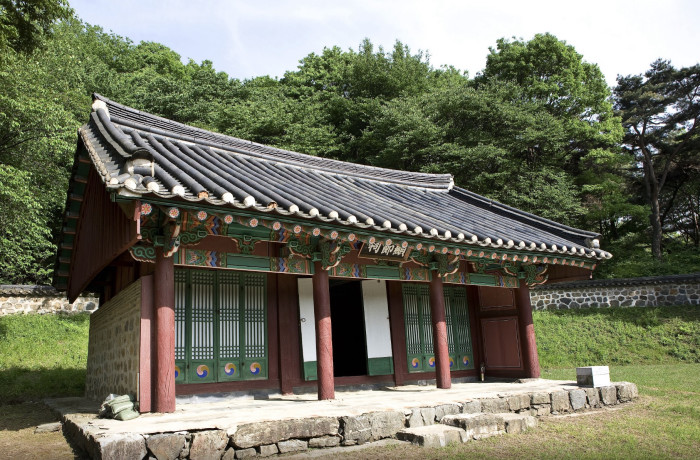
Hyeonjeolsa Shrine(including private academy)
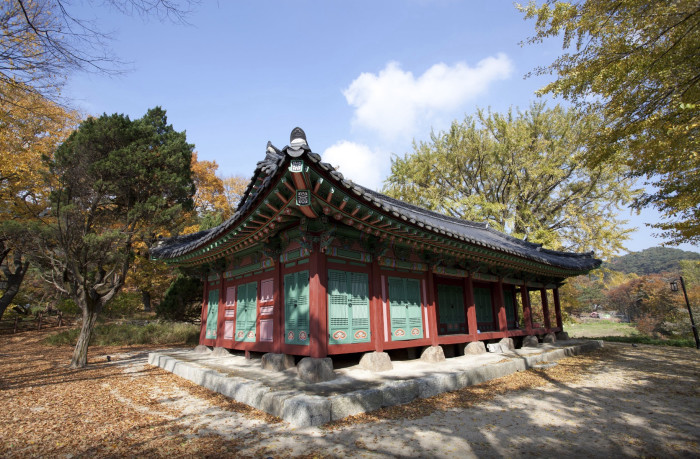
Chimgwaejeong Arsenal
This building was long believed to have been used for an armory. However, it most likely served as an office, as the structure includes ondol heated rooms, an unheated open floor and a corridor-like back veranda. The precise year when this pavilion was built is not known, but Deputy Commander Cheng Long (程龍), a Ming Envoy who visited Joseon, called the structure a "general arsenal" (摠戎武庫) in his writings.
Gwangju Special Mayor Yi Ki-jin had the facility renovated in 1751 and renamed it Chimgwaejeong (枕戈亭 Pavilion of Spears as Pillows, correctly pronounced Chim "gwa " jeong). Apparently, a weapons armory and arsenal were once located nearby, and this building had a separate purpose.

Yeonmugwan Pavillion, Pavilion for command and military training
This structure is believed to have been first built as Yeonmudang (演武堂 Hall for Practicing Martial Arts) in 1624, during the initial construction of Namhan Mountain Fortress. Defense Commander Kim Jwa-myeong had the facility rebuilt during the reign of King Sukjong (1674-1720) and hung a tablet that designated it as Yeonmugwan (演武館 Guesthouse for Practicing Martial Arts). In King Yeongjo's reign (1724-76), it was renamed Sueoyeong (守禦營) but still referred to as a hall for military training. Yeonmugwan is massive, with a floor space of some 330 square meters, and is placed on a high foundation, making it visible from a distance. Crossbeams inside the hall have dragon images painted on both sides, while phoenixes are painted on the side beams.
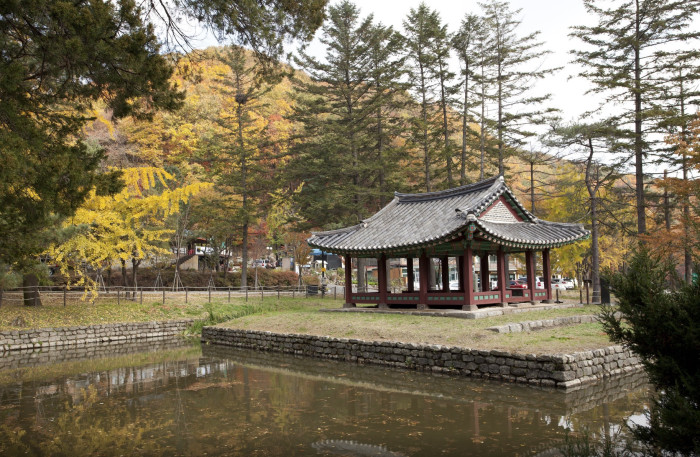
Jisudang Pondside Pavilion
County Magistrate Yi Se-hwa had Jisudang (池水堂 Pond Water Hall) built as a pond-side pavilion in 1672. At the time, it was surrounded by three lotus ponds, although only two remain today. A stele extolling the accomplishments of County Magistrate Yi has been erected east of the pavilion. A rice paddy now occupies the spot believed to have been the third pond. South of the pavilion lies a stream that flows west to east. The ponds originally surrounded the pavilion in a "U" shape, but a great flood destroyed it all in 1925. Recently, the site was restored on the basis of extant historical records.
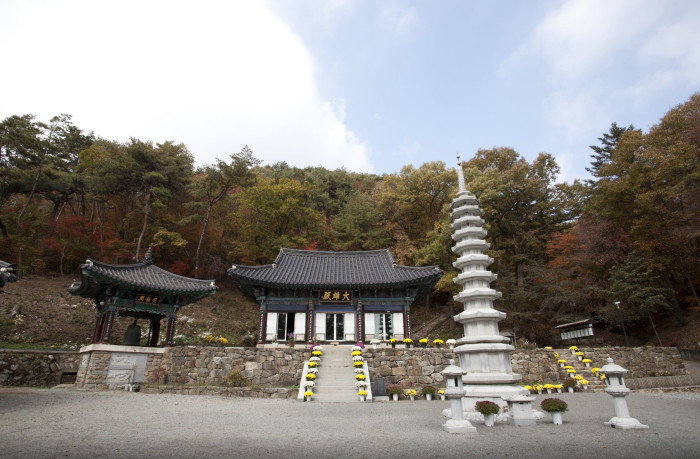
Janggyeongsa Temple
Janggyeongsa (長慶寺) is inside the fortress walls, about 500m east of the East Gate. The temple, which been designated a "cultural property material" of Gyeonggi Province, includes a main hall, temple office, shrine to the mountain spirit, bell tower, pagoda and two residential halls for monks. All ten temples that were once part of Namhan Mountain Fortress were destroyed, but Temple Janggyeongsa, less so than the others and today offers a partial glimpse at what it once looked like. Rhododendrons thrive behind the temple compound, and mushrooms grow in the old pine groves. A wonderful view of the various temple sites can be seen from a lookout south of Jinnamnu.
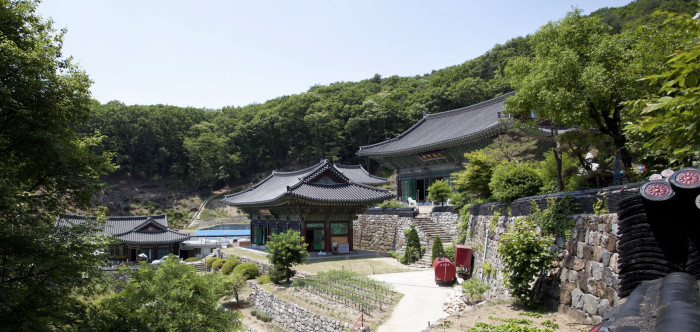
Site of temple Mangwolsa
The temple that once occupied this site has the longest history of the ten temples that once stood inside Namhan Mountain Fortress. Mangwolsa (望月寺), the temple, began as Mangwolam (望月庵), the hermitage, during the Goryeo Period. According to one account, when Yi Seonggye (King Taejo) founded Joseon and decided on Hangyang (Seoul) as the new capital, Jeongeuisa, which was there, was torn down. The story goes on to say that the Buddha statuary and a copy of the Lotus Sutra, written in gold, was moved from that temple to this temple inside Namsan Mountain Fortress. However, the description of the temple from the Annals of Hannam is no longer existent. Probably, this temple was included on the list (weapons, gunpowder, temples and other facilities) that was ordered destroyed or removed by the Japanese authorities. New construction is now underway here in an effort to reconnect Mangwolsa with its past.

Site of temple Gaewonsa
Gaewonsa (開元寺) once stood in the southern part of the fortress compound. A description of the temple history can be found on a sign inside and to the right of the "one-pillar" gate (the main entrance): "Gaewonsa was established in 1624 as the main temple to direct the monks who were conscripted from around the kingdom to rebuild Namhan Mountain Fortress, destroyed during the Imjin War with Japan. The temple was destroyed by the Japanese authorities in 1907 and is now under reconstruction.
<ggc의 모든 콘텐츠는 저작권법의 보호를 받습니다.>
- 글쓴이
- 지지씨
- 자기소개